June 1912: Selling Suffrage and Sandwiches at the Portland Rose Festival
“Votes-for-Women Ballyho Wagon, Pike Davis Spieling, Will Furnish Sandwiches,” Portland Evening Telegram, June 8, 1912, 2.
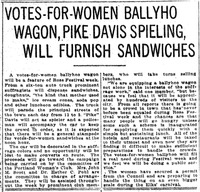 The Portland Rose Festival was in its fifth year in 1912 and members of the Portland Woman’s Club Suffrage Campaign Committee capitalized on the event as an occasion to promote the votes for women campaign in full swing that summer. The suffrage lunch wagon was a popular hit and brought a great deal of publicity to the cause.
The Portland Rose Festival was in its fifth year in 1912 and members of the Portland Woman’s Club Suffrage Campaign Committee capitalized on the event as an occasion to promote the votes for women campaign in full swing that summer. The suffrage lunch wagon was a popular hit and brought a great deal of publicity to the cause.
Campaign committee members, led by Esther Pohl, used the kitchen of the Women of Woodcraft Hall to prepare sandwiches, ice cream, doughnuts and soda to sell from noon until 2:00 each day of Rose Festival week. They decorated a Speedwell truck with votes for women banners and bunting in suffrage white and yellow and rode through the streets selling sandwiches and suffrage to the crowd.
W.M. “Pike Davis, head of the Multnomah County Men’s Equal Suffrage League, was on board the suffrage lunch wagon to call out to the crowds. When it rained, as sometimes happens in Portland in June, workers unfurled a large votes-for-women umbrella.
The use of popular media and participation in parades was part of the new votes for women movement of the early twentieth century. The Oregon campaign benefitted from the successful popular promotion of the suffrage cause.
Additional Reading:
“Buns to Boost Suffrage,” Oregonian, June 10, 1912, 10.
“Hot Cakes Not In It,” Oregonian, June 12, 1912, 9.
Want to read more articles from Oregon suffrage campaigns? Click here
Permalink
May 1912
“Suffrage Interest Keen: Speakers Engaged to Conduct Educational Campaign at Grants Pass,” The Oregonian, May 20, 1912, 7.
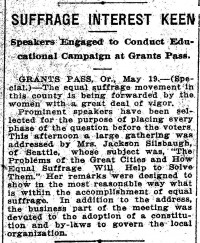
The article also indicates that Josephine County suffragists were working to organize their group for effective action at the local level, another important ingredient for success.
And finally, the article showcases another vital feature of successful suffrage organizing - networking and support across states. Seattle’s Rosetta Silbaugh had been involved in Washington state suffrage activities in 1910 and provided a voice of experience in this meeting. Cross-state cooperation was not confined to suffrage alone. Two years later Silbaugh would work with Oregon activist Caroline J. Gleason and other Industrial Welfare Commission members in Washington and Oregon to report on conditions for women wage-earners. Suffrage activism led the way to other modes of activism after the campaign was completed.
*(not Silsbaugh as The Oregonian had it)
Additional Reading:
Caroline J. Gleason (Sister Miriam Theresa), Report of the Industrial Welfare Commission of the State of Washington on the Wages, Conditions of Work, and Costs and Standards of Living of Women Wage Earners in Washington (Olympia: Washington State Industrial Welfare Commission, 1914)
Want to read more articles from Oregon suffrage campaigns? Click here
Permalink
April 1906
“Conference on Suffrage: One Hundred Women Are Expected to Attend Sessions,” The Oregonian, April 3, 1906, 14.
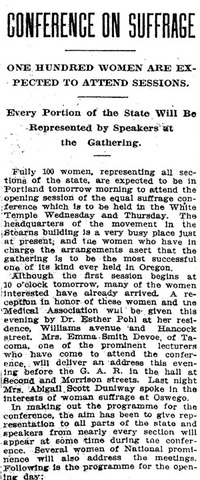 Oregon suffragists prepared for the June 1906 election that would bring the question of votes for women to the ballot after the resounding send-off given to the campaign at the 1905 National American Woman Suffrage Association meeting at the Lewis and Clark Exposition in the summer of 1905.
Oregon suffragists prepared for the June 1906 election that would bring the question of votes for women to the ballot after the resounding send-off given to the campaign at the 1905 National American Woman Suffrage Association meeting at the Lewis and Clark Exposition in the summer of 1905.
On April 4, 1906, suffrage supporters from around the state gathered to network and gain Thumbnail image for Thumbnail image for Thumbnail for OR 4 3 1906 14, sm.jpgmomentum for the final months of the 1906 campaign and to greet national leaders, including National American Woman Suffrage Association president Anna Howard Shaw. The day-long conference, held in Portland, brought major players in Oregon woman suffrage, labor, and reform groups from a variety of professions and occupations.
The afternoon session included talks by Mary A. Thompson, M.D. on “The Qualifications of Voters,” “Woman and the Municipality,” by Grace Watt Ross, president of the Portland Woman’s Club, and “The Welfare of the Child,” by Millie Trumbull.
At the evening session Abigail Scott Duniway addressed the group on “Marching on to Victory,” and Sarah A. Evans, president of the Oregon State Federation of Women’s Clubs, spoke on the “Advantage of the Ballot to the Clubwoman,” Eva Emery Dye on “Oregon’s Debt to Women,” and Luema G. Johnson of the Union Label League and the State Federation of Labor on “The Wage-Earner.” This session also included remarks by Clara Waldo of the Oregon Grange on “The Influence of the Woman on the Farm,” and Esther Pohl, M.D. on “The Debt of the Professional Woman to the Pioneer Suffragists.”
Organizers hoped to bring together suffrage supporters from many parts of the state and representing different organizations and groups of women to enhance their appeal for votes for women that June.
Want to read more articles from Oregon suffrage campaigns? Click here
Permalink
March, 1912
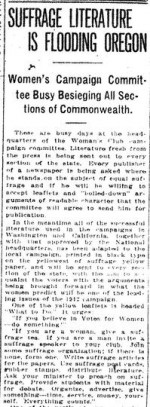 The Oregon woman suffrage campaign of 1912 exemplifies the “new” movement for woman suffrage in many ways, including the strategic use of mass advertising for the cause. The Woman Suffrage Campaign Committee of the Portland Woman’s Club, led by Sara Evans, Grace Watt Ross and Esther Pohl Lovejoy, secured the talents of journalist Nan Strandborg to assist with publicity.
The Oregon woman suffrage campaign of 1912 exemplifies the “new” movement for woman suffrage in many ways, including the strategic use of mass advertising for the cause. The Woman Suffrage Campaign Committee of the Portland Woman’s Club, led by Sara Evans, Grace Watt Ross and Esther Pohl Lovejoy, secured the talents of journalist Nan Strandborg to assist with publicity.
This article from the Portland Evening Telegram indicates that by March 1912 the campaign committee was contacting publishers of newspapers across the state for their stance on suffrage. Strandborg created “leaflets and ‘boiled-down’ arguments of readable character” for editors to publish - press releases for the mass media.
Oregon suffragists utilized campaign literature from the National American Woman Suffrage Association and “all of the successful literature used in the campaigns in Washington and California.” Adapting materials that had helped Washington suffragists gain victory in 1910 and those California in 1911 to local needs around Oregon, Strandborg and the committee used “the yellowest of suffrage yellow paper” to draw the attention of readers.
Suffrage campaign literature was not only eye-catching; it offered specific suggestions for action for both male and female supporters. “‘Organize, advertise, give something - time, service, money, yourself. Everything counts.’”
Additional reading
Margaret Finnegan, Selling Suffrage: Consumer Culture and Votes for Women (New York: Columbia University Press, 1999)
Gayle Gullett, Becoming Citizens: The Emergence and Development of the California Women’s Movement, 1880-1911 (Urbana: University of Illinois Press, 2000)
Kimberly Jensen, “‘Neither Head nor Tail to the Campaign’: Esther Pohl Lovejoy and the Oregon Woman Suffrage Victory of 1912,” Oregon Historical Quarterly 108:3 (Fall 2007): 350-383.
Rebecca Mead, How the Vote Was Won: Woman Suffrage in the Western United States, 1868-1914 (New York: New York University Press, 2004)
Want to read more articles from Oregon suffrage campaigns? Click here
Permalink
February, 1874
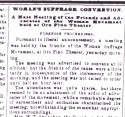 On the first day of the convention that would create the Oregon Woman Suffrage Association the weather was “inclement” and the “Mass Meeting of the Friends and Advocates of the Woman Movement” at Portland’s Oro Fino Theater started a half an hour late. Perhaps organizers hoped that more supporters would venture out in the rain. Though small in numbers, this organizing meeting for the first state suffrage organization in Oregon had a “remarkable degree of earnestness and enthusiasm.” The men and women gathered decided to organize a state equal suffrage society “to secure more united action and influence in the work.”
On the first day of the convention that would create the Oregon Woman Suffrage Association the weather was “inclement” and the “Mass Meeting of the Friends and Advocates of the Woman Movement” at Portland’s Oro Fino Theater started a half an hour late. Perhaps organizers hoped that more supporters would venture out in the rain. Though small in numbers, this organizing meeting for the first state suffrage organization in Oregon had a “remarkable degree of earnestness and enthusiasm.” The men and women gathered decided to organize a state equal suffrage society “to secure more united action and influence in the work.”
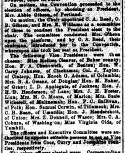 The OWSA appealed “to the citizens of Oregon who believe in the principle of ‘equality before the law’ to aid this Association in every possible way by placing these self-evident truths before the people that all men and women are created equal, and of right ought to be equally free and independent in law, custom, and ethos, and we urge them to proceed at once to perfect the different county organizations throughout the State.”
The OWSA appealed “to the citizens of Oregon who believe in the principle of ‘equality before the law’ to aid this Association in every possible way by placing these self-evident truths before the people that all men and women are created equal, and of right ought to be equally free and independent in law, custom, and ethos, and we urge them to proceed at once to perfect the different county organizations throughout the State.”
On the afternoon of the first day, February 14, 1873 those present elected Abbie Gibson of Portland as president of the Oregon Woman Suffrage Association, with various vice presidents representing Oregon counties and an executive committee. From the beginning women and men from around the state were officers in the association.
OR 3 17 1873 3.jpgOn the second day an African American suffragist from Portland, Mrs. Mary Beatty, addressed the group. Portland historian Tim Hills has located Mary Beatty in the Portland City Directory as a dressmaker married to J.W. Beatty. Three months earlier Beatty had joined three other Portland suffragists, Abigail Scott Duniway, Maria Hendee, and Mrs. M.A. Lambert, in attempting to vote in the presidential election of November 1872.
Other participants included Abigail Scott Duniway, Mary Anna Thompson, M.D., Bethenia Owens (later Owens-Adair) M.D. and Colonel C. A. Reed of Salem.
Want to read more articles from Oregon suffrage campaigns? Click here
Permalink

